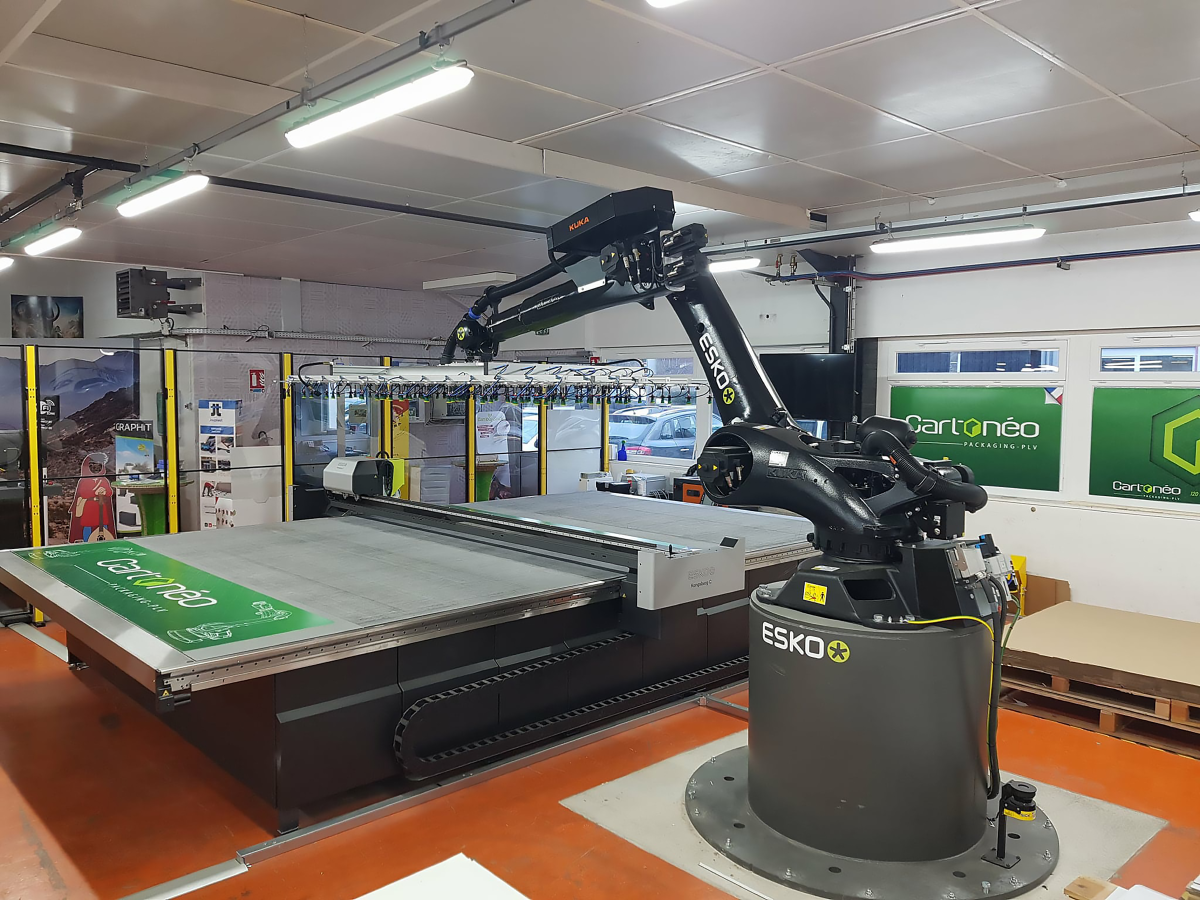When it comes to digital transformation of your business, are you at the cutting edge or merely sitting on the ledge? Have you even begun to ask yourself what your business needs to do to remain competitive in a more automated world? Jan De Roeck, director solutions managment, Esko, challenges you to think, digitise, automate, connect.

Automation seems to have been the underlying theme for many decades in various industries. In modern history, each industrial revolution (according to the German government we’re now in the fourth industrial revolution) has brought forward major steps in process and workflow automation. Now we are aware of rapid advances in artificial intelligence and robotics which are capable of changing the landscape of the future - but when analysing what automation really means for the wide-format industry, we can easily conclude that this may be somewhat different from other industries.
A modern car assembly line has very few similarities with a shopfloor producing free stand-up displays, yet both will rely heavily on workflow automation. We believe there is a different automation game to be played in the wide-format sector, and it’s all related to digitisation of production steps, automation of repetitive tasks and connectivity between systems, people and processes. How far are you on this journey?
Observing the wide-format printing business from a distance and asking ourselves what are the main characteristics of this business, we immediately notice a high variation in applications. These in turn drive a high variation in the choice of substrates and components and consequently printing technologies and production methods. In wide-format print production, you will find anything from high volume flexo printed corrugated shipping boxes to offset litho laminated high quality displays and roll-to-roll inkjet printed vehicle wraps.
These business are experiencing continued growth, with increasingly higher job-volumes that require more material handling operations than ever before. We see instances of multi-part display production where several parts - readily printed and die-cut - wait for days in inventory because the other parts(s) are not ready, or in some case, still waiting for substrates to be delivered. Given these characteristics, it’s obvious that we operate in a unique business environment with its own unique challenges.
Digitise
One of these challenges is that while brands continue to search for new ways to approach the consumer, displays will continue to be more and more creative and in many cases more complicated to produce. Consumers are now looking to be entertained. Its not so much about the products, it is more about the experience. Embedded electronics, intricate displays and sensory appeal are all designed to seduce the consumer. Whilst designers strive to meet the demands of the brand owners, wide-format printers are faced with a complexity of products and multi-part POPs which all require finishing, parts picking, assembly, packing and shipping.
At the design stage it is important to design with the end product in mind in order to eliminate waste creation along the path. Esko’s optimised packaging and display templates ensure maximum performance of the CAD design in each step of the process. Using ArtiosCad’s library of pre-designed production ready displays, a designer can maximise his creativity. There are endless and resizable variations including 2D and 3D plus reports and videos. Our online, cloud-based library of ‘downloadable’ designs have all been tested, ready for the customer to add their own graphics, thus making it easy to test new concepts in the market. The workflow for 3D displays can be a little more complicated because it requires structural design but this is where Esko’s long experience and sophisticated visualisation software can help too.
The choice of substrate is also a consideration with so many to choose from - folding carton, corrugated, solid boards, foam, acrylics, wood, fiberglass and metals. Esko’s pre-configured workflow tools can handle multiple substrate choices for the wide-format sector.
A key factor in manufacturing efficiency is the speed with which artwork is prepared for print and how fast production can begin after the customer has approved the quote. Esko has developed a single design canvas on screen so that the user can control and manage every component part of the job with clear visibility. Changes can be made on the fly from 3D to 2D and then back to 3D. The design, the material, the dimensions - can all be adjusted immediately on one screen with one click. The ability to display complex designs and headers and rebuild and create holistic designs at high speed in 3D is unique to Esko. Printers need never turn away a job again through lack of expertise.
Automate
One of the big advantages of automation is transparency. Every step of the workflow through to finishing and shipping matters and the key to workflow efficiency is to identify all the areas of waste and standardise processes. Identifying problems in individual processes is not so difficult - its understanding how each step of the workflow performs together that can often be complex.
Production equipment - both digital printing and digital finishing presses - will gradually get faster and more efficient, but this will happen in an environment where manual labour will remain important to the post-press process. We need to look at different areas where digitisation of the workflow adds value. High variance in applications will continue to require a high level of human labour in the post press department.
In the future, workers will be assisted more by robotics and intelligent solutions based on the principles of Industry 4.0 but for the foreseeable future, robots will complement manual labour, not make it redundant. To illustrate this, what is the point if your digital roll-to-roll colour printer can spit out a vehicle wrap for a small van in under 30 minutes instead of two hours as previously - if applying the vehicle wrap to the van takes two full eight-hour shifts? But a more optimal processing and scheduling of such jobs from order entry to shipping, will positively impact overall efficiency and productivity.
In the finishing room, Esko has thought of every timesaving measure and device to reduce ‘changeover time’ and simplify waste logistics. With a range of cutting tables, feeders, stackers and tooling systems to suit all needs, Esko provides an automation opportunity to multi-task with multi-zone operations using powerful robotics for faster and more versatile material handling. The operator can clear and prepare one zone while alternative tables are set up to continue to work on other parts of the production.
Connect
The Internet of Things - IoT and Industry 4.0 are the enablers for a more ‘connected’ workflow that is data driven so that the above examples will no longer cause delays and overhead costs in the future. Data driven workflow, IoT connected pallets and machines, electronic job cards, even RFID identification of single objects, will create a full Industry 4.0 enabled workflow environment.
But we shouldn’t look too far into the future for better connectivity across disparate systems. A production management platform will connect people, processes and systems merely by linking all operations on the same platform, organised and managed. Why would an administrative person need to continuously send reminder emails to various stakeholders to make a project move forward? A well-integrated collaboration platform like Esko WebCenter will ensure projects are driven forward in an automated fashion, using reminders right on the operators’ desktops. Connectivity with devices like the Kongsberg digital cutting machine will provide instant job status updates and reports machine availability in real time. Our software shares the data and synchronises the information throughout multiple platforms and multiple devices.
Looking further out into the future, IoT connected tables and printers from different vendors will all be centrally managed for optimal planning and scheduling of work. This is where the advantages of in-house finishing come into play. The planning and control are all yours.
And what about connecting with the back-end of the process? Esko’s Cape Pack Software has been developed for efficient stacking, loading and space utilisation managing more products and pallets within a single truck. Cape Truckfill optimises product loads into trucks and containers to save on shipping costs. And this technology connects the design department with the shipping logistics providing wide-format printers with an extremely powerful tool to save transportation costs and be a hero for their customers.
Discovering opportunities for your own shop floor
Understanding the benefits of each of the individual steps in digitising, automating and connecting may be possible, but finding out which step will lead to the biggest improvement impact for your business is something different. Starting from a company’s overall business strategy, Esko provides advice for the entire door-todoor workflow, from receiving an order all the way to packing and shipping the order to the customer.
Together with the operators, an Esko solution architect will analyse each production step, provide a visual representation of the workflow, expose bottlenecks in production and analyse areas of improvement. Supported by the principles of ‘Value Stream Mapping’, such discovery workshops result in an easy to understand and quantified report that lists and prioritises the main opportunities for improvement. Esko’s purpose is not to offer products to address each individual element, it is about reviewing the complete workflow from ‘order in’ to ‘shipping a product out’ and achieving an overall solution.
Esko starts the process by working together with a company’s team and asking the questions: What keeps you awake at night - production speeds, waste reduction, materials handling, short delivery times, time pressure, new trends and consumer demands, addressing a wider variety of orders? Do you worry that your staff have all the skills and expertise necessary to meet the complexities of your business model? Where are your bottlenecks? Importantly, what is it you want to achieve?
Once each part of the process has been addressed and improved, full automation can then be achieved by looking at which steps in the workflow can be digitised, where you can apply automation and where will you be able to connect the pieces together to bring about a complete process of functional activity.
With current sociological demand for instant gratification, the aggressive drive for competitive edge and world pressure to reduce waste all business need to look at the options to address the trends and speed up production, eliminate bottlenecks and automate processes. No one is suggesting full automation is an overnight project but with the right partner and taking a step at a time it is possible to add value to your business. The Esko advice is ‘digitise, automate, connect’.


